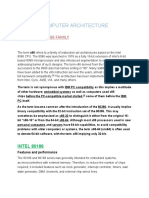Efm 32 GG
Efm 32 GG
Uploaded by
Javier Pueyo SerranoCopyright:
Available Formats
Efm 32 GG
Efm 32 GG
Uploaded by
Javier Pueyo SerranoOriginal Description:
Original Title
Copyright
Available Formats
Share this document
Did you find this document useful?
Is this content inappropriate?
Copyright:
Available Formats
Efm 32 GG
Efm 32 GG
Uploaded by
Javier Pueyo SerranoCopyright:
Available Formats
EFM32GG Data Sheet
System Summary
3. System Summary
3.1 System Introduction
The EFM32 MCUs are the world’s most energy friendly microcontrollers. With a unique combination of the powerful 32-bit ARM Cortex-
M3, innovative low energy techniques, short wake-up time from energy saving modes, and a wide selection of peripherals, the
EFM32GG microcontroller is well suited for any battery operated application as well as other systems requiring high performance and
low-energy consumption. This section gives a short introduction to each of the modules in general terms and also shows a summary of
the configuration for the EFM32GG devices. For a complete feature set and in-depth information on the modules, refer to the
EFM32GG Reference Manual.
A block diagram of the EFM32GG is shown in the following figure.
Core / Memory Clock Management Energy Management Security
High Frequency High Frequency Voltage Voltage
ARM CortexTM Memory Crystal Oscillator RC Oscillator Regulator Comparator Hardware AES
M3 processor Protection Unit
Auxiliary High Low Freq. Brown-out Power-on
Flash Program Freq. RC Osc. RC Oscillator Detector Reset
Debug w/ ETM
Memory
Low Frequency Ultra Low Freq. Back-up Power
RAM Memory DMA Controller Crystal Oscillator RC Oscillator Domain
32-bit bus
Peripheral Reflex System
Serial Interfaces I/O Ports Timers and Triggers Analog Interfaces
External Bus Timer/Counter LESENSE
USART UART TFT Driver ADC LCD Controller
Interface
Low Energy Timer Real Time Counter
Low Energy External General Operational
I2C DAC
UARTTM Interrupts Purpose I/O Amplifier
Pulse Counter Watchdog Timer
Analog
USB Pin Reset Pin Wakeup Back-up RTC Comparator
Lowest power mode with peripheral operational:
EM0 - Active EM1 - Sleep EM2 – Deep Sleep EM3 - Stop EM4 - Shutoff
Figure 3.1. Block Diagram
3.1.1 ARM Cortex-M3 Core
The ARM Cortex-M3 includes a 32-bit RISC processor which can achieve as much as 1.25 Dhrystone MIPS/MHz. A Memory Protection
Unit with support for up to 8 memory segments is included, as well as a Wake-up Interrupt Controller handling interrupts triggered while
the CPU is asleep. The EFM32 implementation of the Cortex-M3 is described in detail in EFM32GG Reference Manual.
3.1.2 Debug Interface (DBG)
This device includes hardware debug support through a 2-pin serial-wire debug interface and an Embedded Trace Module (ETM) for
data/instruction tracing. In addition there is also a 1-wire Serial Wire Viewer pin which can be used to output profiling information, data
trace and software-generated messages.
3.1.3 Memory System Controller (MSC)
The Memory System Controller (MSC) is the program memory unit of the EFM32GG microcontroller. The flash memory is readable and
writable from both the Cortex-M3 and DMA. The flash memory is divided into two blocks; the main block and the information block.
Program code is normally written to the main block. Additionally, the information block is available for special user data and flash lock
bits. There is also a read-only page in the information block containing system and device calibration data. Read and write operations
are supported in the energy modes EM0 and EM1.
silabs.com | Building a more connected world. Rev. 2.1 | 12
You might also like
- Morris Mano - Computer Architecture PPT Chapter 7Document26 pagesMorris Mano - Computer Architecture PPT Chapter 7Anmol Agrawal100% (2)
- Efm32 Gecko Family Efm32G Data Sheet: The Efm32 Gecko Mcus Are The World'S Most Energy-Friendly Mi-CrocontrollersDocument206 pagesEfm32 Gecko Family Efm32G Data Sheet: The Efm32 Gecko Mcus Are The World'S Most Energy-Friendly Mi-CrocontrollersElectronica Analogica Y DigitalNo ratings yet
- EFM32 Zero Gecko Family EFM32ZG Data SheetDocument104 pagesEFM32 Zero Gecko Family EFM32ZG Data SheetHans ClarinNo ratings yet
- Efr32fg23 DatasheetDocument145 pagesEfr32fg23 DatasheetGustavo Carlos da SilvaNo ratings yet
- Efm32hg Datasheet-1500479Document170 pagesEfm32hg Datasheet-1500479diego doriniNo ratings yet
- datasheetDocument79 pagesdatasheetLeonardo Felipe Takao HirataNo ratings yet
- Efm32gg12 DatasheetDocument236 pagesEfm32gg12 DatasheetLaboratronica ArgentinaNo ratings yet
- EFM32G200Document67 pagesEFM32G200Larry LawrenceNo ratings yet
- ADuCM350-Amperometric, Voltametric, and ImpedometricDocument40 pagesADuCM350-Amperometric, Voltametric, and Impedometricestraj1954No ratings yet
- zgm230s DatasheetDocument50 pageszgm230s DatasheetColin HwangNo ratings yet
- Efm32G890 Datasheet: EFM32G890 Microcontrollers Are Suited For All Battery Operated ApplicationsDocument71 pagesEfm32G890 Datasheet: EFM32G890 Microcontrollers Are Suited For All Battery Operated ApplicationsamerosperosNo ratings yet
- ICT Lecture AssignmentDocument8 pagesICT Lecture Assignmentabdurahmanaref05No ratings yet
- BGM220P Wireless Gecko Bluetooth Module Data SheetDocument49 pagesBGM220P Wireless Gecko Bluetooth Module Data SheetVenkat KrishnanNo ratings yet
- EFM32TG842F32Document65 pagesEFM32TG842F32Vasia PetrovNo ratings yet
- IRMCS3041: Sensorless Motor Drive Platform For Appliance Based On iMOTION ChipsetDocument11 pagesIRMCS3041: Sensorless Motor Drive Platform For Appliance Based On iMOTION ChipsetAmirNo ratings yet
- SKEA64PB, Product Brief - Product BriefDocument14 pagesSKEA64PB, Product Brief - Product BriefMayank VyasNo ratings yet
- Efm32Gg280 Datasheet: 32-Bit ARM Cortex-M0+, Cortex-M3 and Cortex-M4 Microcontrollers ForDocument80 pagesEfm32Gg280 Datasheet: 32-Bit ARM Cortex-M0+, Cortex-M3 and Cortex-M4 Microcontrollers ForFrancisval GuedesNo ratings yet
- en.DM00490980Document60 pagesen.DM00490980crisptinkleNo ratings yet
- Meter PDFDocument20 pagesMeter PDFartovolastiNo ratings yet
- IRMCF341: Sensorless Motor Control IC For AppliancesDocument32 pagesIRMCF341: Sensorless Motor Control IC For AppliancesAbid ali SiddiquiNo ratings yet
- Embedded System Application: Serial CommunicationDocument71 pagesEmbedded System Application: Serial CommunicationMULLAIVANESH A VNo ratings yet
- Unit 2 Cortex M ArchitectureDocument84 pagesUnit 2 Cortex M Architecturemiyogi6466No ratings yet
- EFM8 Busy Bee Family EFM8BB1 Reference ManualDocument231 pagesEFM8 Busy Bee Family EFM8BB1 Reference ManualFrancesco MenichelliNo ratings yet
- Apollo MCU DatasheetDocument388 pagesApollo MCU DatasheetShubhanshu RawatNo ratings yet
- Silicon Labs Efm8ub20f64g B QFP48R - C2053313Document57 pagesSilicon Labs Efm8ub20f64g B QFP48R - C2053313TNo ratings yet
- ELEC3300 - 03-Embedded System StructureDocument27 pagesELEC3300 - 03-Embedded System StructureKwun Hok ChongNo ratings yet
- Efm8lb1 DatasheetDocument77 pagesEfm8lb1 DatasheetJakieNo ratings yet
- Efm8bb10f8g-A-Qfn20r - 1 - 1Document1 pageEfm8bb10f8g-A-Qfn20r - 1 - 1iet mitNo ratings yet
- 07 Efr32mg21-DatasheetDocument143 pages07 Efr32mg21-DatasheetTiago AgneloNo ratings yet
- 8051 UcDocument84 pages8051 UcAryan KarhadeNo ratings yet
- MAX32520Document29 pagesMAX32520duval fortesNo ratings yet
- Um1749 Description of stm32l0 Hal and Lowlayer Drivers StmicroelectronicsDocument1,694 pagesUm1749 Description of stm32l0 Hal and Lowlayer Drivers StmicroelectronicsYure AlbuquerqueNo ratings yet
- Module - 02 ArchitectureDocument18 pagesModule - 02 ArchitectureMaria MEKLINo ratings yet
- ATmega32 SummaryDocument18 pagesATmega32 SummaryRajesh KumarNo ratings yet
- (T) EE2028 Topic 6 Interfacing Concepts, GPIODocument42 pages(T) EE2028 Topic 6 Interfacing Concepts, GPIOAlex CarmonaNo ratings yet
- ATmega32A SummaryDocument23 pagesATmega32A Summarybg632707No ratings yet
- ArmDocument11 pagesArmKakaRonaldoNo ratings yet
- 8-Bit Microcontroller With 32K Bytes In-System Programmable Flash Atmega32ADocument18 pages8-Bit Microcontroller With 32K Bytes In-System Programmable Flash Atmega32Amiusuario_1022No ratings yet
- Arm7Tdmi - Based Microcontroller AT91RM3400: FeaturesDocument30 pagesArm7Tdmi - Based Microcontroller AT91RM3400: Featureshancu georgeNo ratings yet
- Multiple On and Off Time Programmed Industrial Load: Submitted byDocument24 pagesMultiple On and Off Time Programmed Industrial Load: Submitted byakashNo ratings yet
- ESD - DAY 2-PortalDocument35 pagesESD - DAY 2-PortaldraqulaincNo ratings yet
- LPC11E3XDocument71 pagesLPC11E3Xsuhasc899No ratings yet
- Efm32lg330 DatasheetDocument66 pagesEfm32lg330 Datasheet王宗超No ratings yet
- Day2-Iot Master ClassportalDocument36 pagesDay2-Iot Master ClassportalBhanu PediredlaNo ratings yet
- At Mega 32Document346 pagesAt Mega 32Francisco GomezNo ratings yet
- Datasheet Atmega32Document346 pagesDatasheet Atmega32Mas NyamNo ratings yet
- Um1884 Stm32l4 Hal Lowlayer DriversDocument2,604 pagesUm1884 Stm32l4 Hal Lowlayer DriversImmortal WizardNo ratings yet
- LPC82XDocument85 pagesLPC82Xb06260626No ratings yet
- On-Board Computer Hardware Development Using ARM Cortex M4 Processor(s)Document17 pagesOn-Board Computer Hardware Development Using ARM Cortex M4 Processor(s)Farid AhmadNo ratings yet
- Leon3ft Rtax AgDocument209 pagesLeon3ft Rtax AgNay Htoo ZawNo ratings yet
- AVR Architecture and ApplicationDocument29 pagesAVR Architecture and Applicationhefawoj62No ratings yet
- VB Notes v3.0Document111 pagesVB Notes v3.0David PrinceNo ratings yet
- Efm8bb3 DatasheetDocument90 pagesEfm8bb3 DatasheetevilplayerindoNo ratings yet
- AVR Lecture 2Document72 pagesAVR Lecture 2Mahrukh Baloch100% (2)
- Data Sheet: PCF7991ATDocument19 pagesData Sheet: PCF7991ATElectronicdeivi DeiviNo ratings yet
- Smartcard MCU With 32-Bit ARM Cortex™ M3 CPU and 416 Kbytes High Density Flash MemoryDocument4 pagesSmartcard MCU With 32-Bit ARM Cortex™ M3 CPU and 416 Kbytes High Density Flash MemoryDomRuanNo ratings yet
- 8-Bit Microcontroller With 128K Bytes of ISP Flash and CAN Controller AT90CAN128 PreliminaryDocument15 pages8-Bit Microcontroller With 128K Bytes of ISP Flash and CAN Controller AT90CAN128 PreliminaryducvillaNo ratings yet
- Preliminary Specifications: Programmed Data Processor Model Three (PDP-3) October, 1960From EverandPreliminary Specifications: Programmed Data Processor Model Three (PDP-3) October, 1960No ratings yet
- Digital Electronics, Computer Architecture and Microprocessor Design PrinciplesFrom EverandDigital Electronics, Computer Architecture and Microprocessor Design PrinciplesNo ratings yet
- Practical Reverse Engineering: x86, x64, ARM, Windows Kernel, Reversing Tools, and ObfuscationFrom EverandPractical Reverse Engineering: x86, x64, ARM, Windows Kernel, Reversing Tools, and ObfuscationNo ratings yet
- Complete Question Banks of All Papers in COA Syllabus PDFDocument6 pagesComplete Question Banks of All Papers in COA Syllabus PDFravapati navadeepsaiNo ratings yet
- MicroprocessorDocument77 pagesMicroprocessorM.Usman RafiqueNo ratings yet
- Accepted ProcessorDocument28 pagesAccepted ProcessorGeo Limpoco LargoNo ratings yet
- 2a. CS602 Microprocessor and Microcontroller - SoftwareDocument44 pages2a. CS602 Microprocessor and Microcontroller - SoftwareRehan NightNo ratings yet
- Different Types of Arduino Boards and Its Uses: What Is An Arduino Board?Document8 pagesDifferent Types of Arduino Boards and Its Uses: What Is An Arduino Board?عبد الله علي عمر بن قديمNo ratings yet
- St. Joseph College of EngineeringDocument25 pagesSt. Joseph College of EngineeringjaisathiNo ratings yet
- Homework 2Document8 pagesHomework 2Deepak BegrajkaNo ratings yet
- DSP ArchitecturesDocument71 pagesDSP ArchitecturesTripuresh JoshiNo ratings yet
- Intel x86 FamilyDocument34 pagesIntel x86 Familyamolkore1375No ratings yet
- Chapter 4 Solutions: Case Study: Implementing A Vector Kernel On A Vector Processor and GPUDocument12 pagesChapter 4 Solutions: Case Study: Implementing A Vector Kernel On A Vector Processor and GPUJan jan1No ratings yet
- Computer Architecture: Assignment: 80X86 FamilyDocument17 pagesComputer Architecture: Assignment: 80X86 FamilyAnjan KumarNo ratings yet
- 1 Introduction To STM32F103 v21Document39 pages1 Introduction To STM32F103 v21Nam Võ KhắcNo ratings yet
- 8051 InterruptDocument21 pages8051 InterruptarunvittoNo ratings yet
- Practice Questions To Set 8Document8 pagesPractice Questions To Set 8NiravNo ratings yet
- Hardware MultithreadingDocument10 pagesHardware MultithreadingFarin KhanNo ratings yet
- 17431-2019-Winter-Model-Answer-Paper (Msbte Study Resources)Document33 pages17431-2019-Winter-Model-Answer-Paper (Msbte Study Resources)anandkendre6No ratings yet
- The Original Guide To Boards 2022Document7 pagesThe Original Guide To Boards 2022gualabaNo ratings yet
- MODULE-2 - AddressingModes - Part 2Document23 pagesMODULE-2 - AddressingModes - Part 2eshwar211104No ratings yet
- Design of A Pipelined Powerpc Processor Using VerilogDocument72 pagesDesign of A Pipelined Powerpc Processor Using VerilogRonald CaravacaNo ratings yet
- Mnemonics, Opcodes and Assembler Languages Rev792011Document16 pagesMnemonics, Opcodes and Assembler Languages Rev792011Mim FauziNo ratings yet
- Practice AssignmentDocument4 pagesPractice Assignmentshriya2413No ratings yet
- s4 CAM July 2022Document2 pagess4 CAM July 2022rensiNo ratings yet
- Arm Cortex M7 Processor DatasheetDocument12 pagesArm Cortex M7 Processor DatasheetAlfonso Hernández MagdalenoNo ratings yet
- COA Assignment Questions All UnitsDocument4 pagesCOA Assignment Questions All UnitsIntrovert CSENo ratings yet
- Software Optimization ManualDocument884 pagesSoftware Optimization Manuala wNo ratings yet
- A Comparative Analysis of Conventional 8051 Micro Controller With Modern Ultra Low Power MSP430Document15 pagesA Comparative Analysis of Conventional 8051 Micro Controller With Modern Ultra Low Power MSP430Nishit ChittoraNo ratings yet
- Basic Computer OrganizationCommon Bus System and InstructionsDocument9 pagesBasic Computer OrganizationCommon Bus System and InstructionsHARI HARAN REDDYNo ratings yet
- Datapath 1Document10 pagesDatapath 1Sandeep Kumar YadlapalliNo ratings yet
- M&M KEC502 Unit-3 Assignment-2Document1 pageM&M KEC502 Unit-3 Assignment-2manavh857No ratings yet

























































































